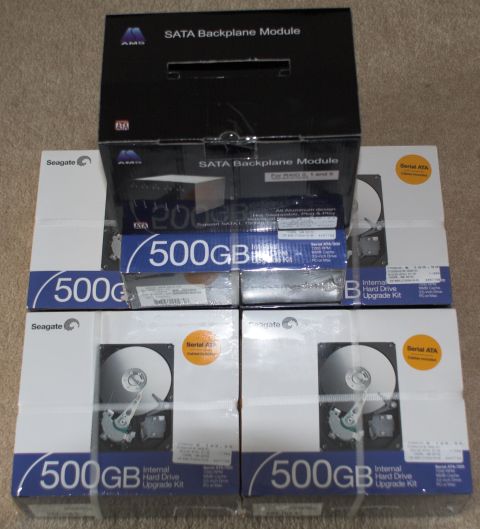2.5 *terabyte* hot-swap storage -- for $730

[UPDATE - See follow up blog on setting up the storage array] I still remember the first hard drive I ever bought. The year was 1992, and I had my friend drive me 70 miles into the silicon valley for the deal of the month in hard drives. The prize at the end of that grueling drive without air conditioning was a whopping 200-megabyte IDE hard drive for the mere price of $499, for which I had to save for months as a starving college student. Ah, those were the "good old days."
Fast forward 15 years later, and I just bought 2.5 terabytes of hot-swappable SATA-300 storage for just under $730. [For a closer look, see my image gallery.] 2.5 terabytes is 2,500,000 megabytes of storage. If I count only the cost of the 500-GB hard drives at $120 each (hard drives were on sale), I'm getting 4166 MB of storage for every dollar. Fifteen years ago, I got 0.4 MB for every dollar and that's not even adjusted to inflation. That's more than 10,000 times the storage for the same dollar, not adjusted for inflation.
Note: I used decimal math, but that's what the hard drive industry likes to use to make its drive sizes sound bigger. Technically, we're suppose to multiply by 1024 twice to convert terabyte to megabyte, but the hard drive industry likes to use decimal math where you multiply by 1000 twice.
| Item | Cost | QTY | Price |
| Seagate ST3500641AS-RK | $119.99 | 5 | $599.95 |
| AMS DS-3151SSBK | $129.99 | 1 | $129.99 |
| Subtotal | $729.94 |
Here are the five 500-GB Seagate hard drives with the hot-swap drive cage. Note that there are 750 GB on the market and even 1000 GB models available any time now, but 500 GB is the sweet spot in terms of maximum bang for the buck. If 1000-GB drives are used in this configuration, that's 5 terabytes of storage!
<Next page - Hot-swap SATA 5-drive cage>
Hot-swap SATA 5-drive cage
Here's a photo of the AMS DS-3151SSBK hot-swap SATA drive cage. The unit fits inside a normal PC chassis using 3 contiguous 5.25" drive bays, and it holds 5 3.5" SATA hard drives. The quick releases felt fairly solid, though not as good as something you get with a high-end server. There are plenty of LEDs in the front to show you drive activity, fan, and power.I can't wait to build a system for this so I can start benchmarking some RAID performance numbers. I'll be using the Intel 965 motherboard with the ICH8R RAID controller, with 6 SATA-300 ports built into the motherboard. From what I've seen so far, the ICH8R has the meanest RAID performance results I've ever seen.
[UPDATE - See follow up blog on setting up the storage array]